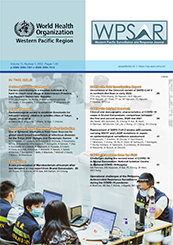Replacement of SARS-CoV-2 strains with variants carrying N501Y and L452R mutations in Japan: an epidemiological surveillance assessment
DOI:
https://doi.org/10.5365/wpsar.2022.13.3.943Keywords:
severe acute respiratory syndrome coronavirus 2, SARS-CoV-2 variants, polymerase chain reaction, infection transmission, surveillanceAbstract
Objective: Monitoring the prevalence of severe acute respiratory syndrome coronavirus 2 (SARS-CoV-2) variants is important due to concerns regarding infectivity, transmissibility, immune evasion and disease severity. We evaluated the temporal and regional replacement of previous SARS-CoV-2 variants by the emergent strains, Alpha and Delta.
Methods: We obtained the results of polymerase chain reaction screening tests for variants conducted in multiple commercial laboratories. Assuming that all previous strains would be replaced by one variant, the new variant detection rate was estimated by fitting a logistic growth model. We estimated the transmission advantage of each new variant over the pre-existing virus strains.
Results: The variant with the N501Y mutation was first identified in the Kinki region in early February 2021, and by early May, it had replaced more than 90% of the previous strains. The variant with the L452R mutation was first detected in the Kanto-Koshin region in mid-May, and by early August, it comprised more than 90% of the circulating strains. Compared with pre-existing strains, the variant with the N501Y mutation showed transmission advantages of 48.2% and 40.3% in the Kanto-Koshin and Kinki regions, respectively, while the variant with the L452R mutation showed transmission advantages of 60.1% and 71.9%, respectively.
Discussion: In Japan, Alpha and Delta variants displayed regional differences in the replacement timing and their relative transmission advantages. Our method is efficient in monitoring and estimating changes in the proportion of variant strains in a timely manner in each region.

